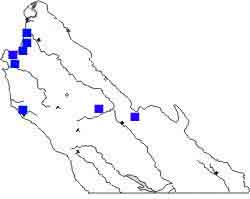|
 Spot-winged Glider is a
typically thin and broad-winged glider. There is a small dark patch on
the hindwing, right at the edge of the body, but this can be quite
difficult to see in flight. The face is red in mature males (e.g., this
collected specimen). The abdomen tends to be darker and browner than
the 'cheesy-yellow' abdomen of Wandering Glider, and it also has a more
complex pattern of darker lines across it. Spot-winged Glider is a
typically thin and broad-winged glider. There is a small dark patch on
the hindwing, right at the edge of the body, but this can be quite
difficult to see in flight. The face is red in mature males (e.g., this
collected specimen). The abdomen tends to be darker and browner than
the 'cheesy-yellow' abdomen of Wandering Glider, and it also has a more
complex pattern of darker lines across it.
Spot-winged Gliders are usually on the wing,
seemingly in constant search for prey. They forage typically from 6 ft
to 100 ft off the ground, and often in swarms with Wandering Glider and
sometimes saddlebags or darners. When they do perch, it is typically at
the tip of a branch, 6 ft. or more off the ground (Manolis 2003).
In MTY, the species was first reported at the Big
Sur River mouth, where Rob Fowler saw it almost daily during June-July
2004. Other records are from August 2006 when individuals or small
parties were found widely at local river mouths and at Laguna Grande
park in Seaside. The lone MTY specimen hit my car at the intersection
of Reservation & Blanco, on the east edge of Marina, on 6 Aug 2006.
In spring 2007, the species was seen at several sites in southern MTY.
|
|
 The map shows the locations of selected
records of Spot-winged Glider. It likely occurs in the lowlands
throughout MTY. It seems to be regular, late in summer, at coastal
river mouths (Salinas, Carmel, Big Sur). It also occurs in swarms of
Wandering Gliders. The map shows the locations of selected
records of Spot-winged Glider. It likely occurs in the lowlands
throughout MTY. It seems to be regular, late in summer, at coastal
river mouths (Salinas, Carmel, Big Sur). It also occurs in swarms of
Wandering Gliders.
Elsewhere in California, flight dates range
from March to October, with a peak from June through August (Manolis
2003). In MTY the records to date range from 17 March-31 August.
|
|
